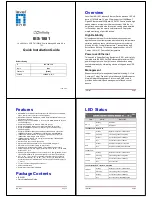
Antaira Technologies - Industrial Ethernet Switches
LMP-0800G-24 Series User Manual V1.0
25
Terms
Value Description
Protocol
“Enable” or “Disable” ERPS protocol
Ring Port 0
ERPS ring port 0, it could be map to real switch port 1
– port 6.
Do not set the same as Ring port 1.
Ring Port 1
ERPS ring port 1, it could be map to real switch port 1
– port 6.
Do not set the same as Ring port 0.
Role
Set the ERPS role as Owner, Neighbor or None.
[Owner]
In charge of blocking one side of RPL link. It will prevent the packet
flow from its blocked port.
[Neighbor]
In charge of blocking one side of RPL link. It will prevent the
packet flow from its blocked port.
[None]
Besides Owner and Neighbor node, the rest of nodes are defined as
None node
.
All node roles have the ability to block the port if the link attach to the port is
failed and disconnected.
Ring ID
ERPS ring ID, ranges from 1 to 239. Ring ID distinguishes different Ring
topology.
Channel
ERPS Channel ID, ranges from 1 to 4094. It’s a channel to send PDUs of
ERPS.
Revertive
Set to Revertive (yes) or Non-revertive (no). The revertive mode works only
under the scenario A at the RPL Owner node.
[Revertive]
While the revertive mode is set, the RPL link will be blocked in 5
minutes after recovery form link failure situation. Otherwise, it will remain
unchanged of the blocking state. That is, the failed link port will block
permanently until the next event happen.
[Non-Revertive]
The failed ring link the port attached to it will remain blocked
even the situation is eliminated.
Click the
“Apply” button to save changes.
Figure 5.23
– ERPS Configuration Terms & Description
















































